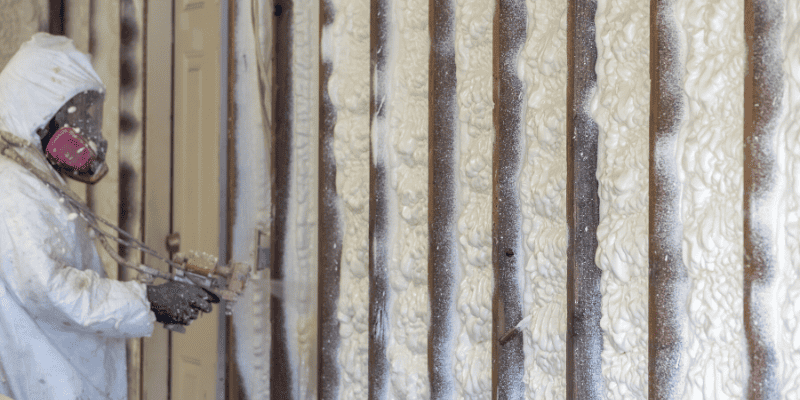During the construction or renovations of a home, there are certain must-haves that need to be placed in the structure of this indoor environment that can contribute to the functioning of several components within the home including ventilation, airflow, climate control, etc. Spray foam insulation is used inside of a home for these very purposes, in an effort to add insulation within the home to trap and contain temperature and thermal insulation, while also minimizing air infiltrations in the indoor space. Although spray foam has an important function inside of your home, it can also present adverse conditions in this indoor space upon its application in the confined environment.
Spray foam insulation will produce a strong chemical odor into the indoor space of a home after it’s installed that can leave this environment with tainted air quality and furthermore could even produce negative health effects to those occupants exposed heavily to these fumes in the air. After you have spray foam insulation applied inside your home, how long should you wait to re-occupy the home to let the chemical fumes dissipate from the air?
In this article, we are going to learn more about spray foam insulation used in a home, along with the chemicals that are used in this building material and how long you should stay out of the house to let the spray foam insulation off-gas in the environment.
Spray foam insulation chemicals
The chemical composition of spray foam can be full of toxic, known hazardous chemicals that will be a compromising threat to the safety of your home’s indoor air quality. There are two chemical reactions that take place during the formation of spray foam, they are known as side A and side B (50/50%). Side A contains an extremely reactive chemical known as isocyanates within its composition, according to the EPA. Isocyanates are a chemical substance that is widely used in the manufacturing of flexible and rigid foams, fibers, and coatings. This chemical is known to be a powerful irritant to the mucous membrane of the eyes and gastrointestinal and respiratory tracts. When isocyanate chemicals come into contact with an individual it could aggravate about of health symptoms that can range in severity from acute to severe.
Side B of spray foam insulation contains a blend of proprietary chemicals that provide unique properties in the foam that include polyols, flame retardants. Blowing agents, amine, surfactants, and other chemicals.
Inhaling spray foam insulation
When it comes to the risks of exposure related to spray foam insulation fumes in your indoor environment, there are many individuals with pre-existing health problems that can be more susceptible to adverse reactions when inhalation of this chemical building material occurs. For those individuals who have a history of skin conditions, respiratory allergies, asthma, or other prior isocyanate sensitizations should be careful when exposure to spray foam insulation is at high levels in their indoor environment. The inhalation of isocyanates produced from spray foam will have a varying degree of harm to an individual’s health, with no recognized safe level of this chemical produced into the air.
If and when spray foam insulation has been applied to and installed throughout your home the levels of isocyanates and other chemical agents will be elevated, and this will create chemical fumes in the environment. These chemical fumes are known as off-gassing chemicals that turn from a solid or liquid to a gas in the air and this will be a chemical reaction that will increase the risks of inhalation of these potentially toxic chemicals.
How long does spray foam insulation off-gas
There is no doubt that after you have applied the polyurethane spray foam insulation within your indoor environment, the off-gassing of the chemical structure of this building material will shortly follow. And when the off-gassing occurs it will lead to volatile indoor air quality, strong chemical odors, and a potentially dangerous environment for occupants to inhabit during the curing time. As we discussed previously, off-gassing is the process in which materials that are composed of chemicals turn to a gaseous compound (usually from a liquid or solid) due to the ambient conditions present in an indoor environment, allowing it to steadily release off into the air.
The question becomes after the application of spray foam insulation how long to stay out of the house before re-inhabiting. When it comes to determining the length of time that spray foam insulation will off-gas in your home for there can be many things that will provoke and exacerbate the off-gassing levels and duration. If you are using a large amount of spray foam inside of your home than you can except for the chemical off-gassing to occur for a longer duration of time. Similarly, if your home has restricted airflow and or ventilation it will also slow down the off-gassing process, leaving the chemicals suspended in the air for longer on average. Typically, however, it is recommended that you avoid long-term exposure to this indoor environment for at least 24 hours after spray foam has been installed to let the curing of the chemical building agent occur in the environment.
Spray foam odor removal solutions
What can you do after spray foam insulation has been placed in your home and is slowly starting to release chemical compounds and odors into the indoor air? The strength and longevity of spray foam odors within a confined environment can be brutal, leaving the environment too volatile for occupants to inhabit this space following its application. However, when it comes to reclaiming your personal indoor environment and mitigating these persisting spray foam chemical odors, the best method may be to deploy an effective air filtration device to clean the air and restore it back to safe, normal conditions.
The EnviroKlenz Air Purifier is an effective air purification device that works specifically to filter out and neutralize a broad spectrum of noxious and toxic chemicals and odors from the air including chemical VOCs like those found in spray foam insulation materials. The proprietary EnviroKlenz® earth mineral technology is formulated to capture, contain, and neutralize an array of chemical and odorous compounds from the air, completely eliminating them from the environment. In addition to the use of this proprietary EnviroKlenz technology, the EnviroKlenz Air Purifier also contains a hospital-grade HEPA filter for fine particulate removal at a 99.99 percent efficiency.

Air System
Mobile Air System
✓ Patented earth mineral technology works to attack VOCs and break them down on a compound level
✓ No chemicals or masking agents
✓ Will not release any chemicals back into your environment
✓ Safer and faster at removing VOC’s than traditional carbon filters and PECO air purifiers
EnviroKlenz® Medical Disclaimer:
“Any information that is provided on this website is not for the use by any commercial or personal entity without expressed written consent of the blog author. The material and statements illustrated within this blog are not intended to diagnose, treat, cure, or prevent any diseases or medical conditions. Nor does the author in any way guarantee or validate the validity, totality, or efficacy of any claims and will therefore not be held responsible for the content of any claims. Always consult your medical physician for any specific medical advice or recommendations.”








